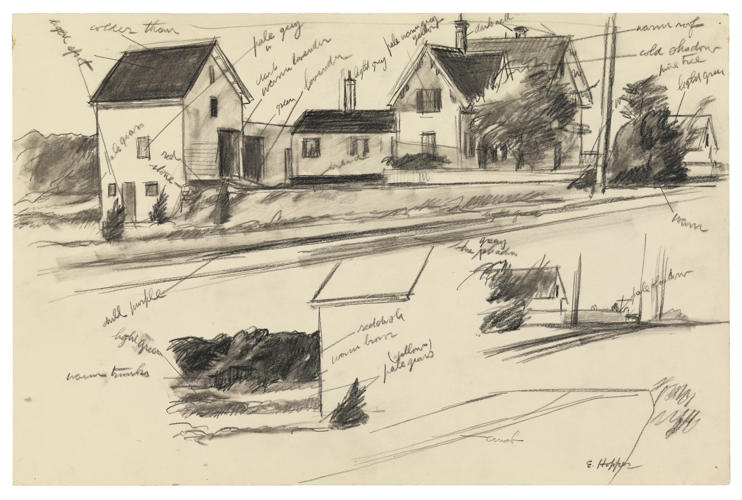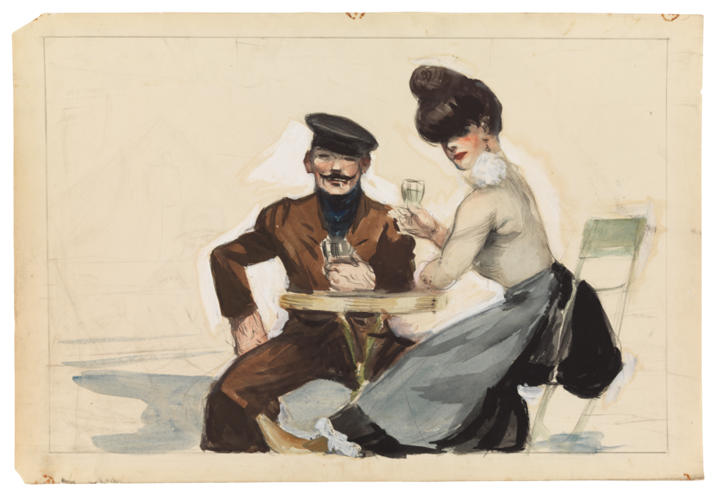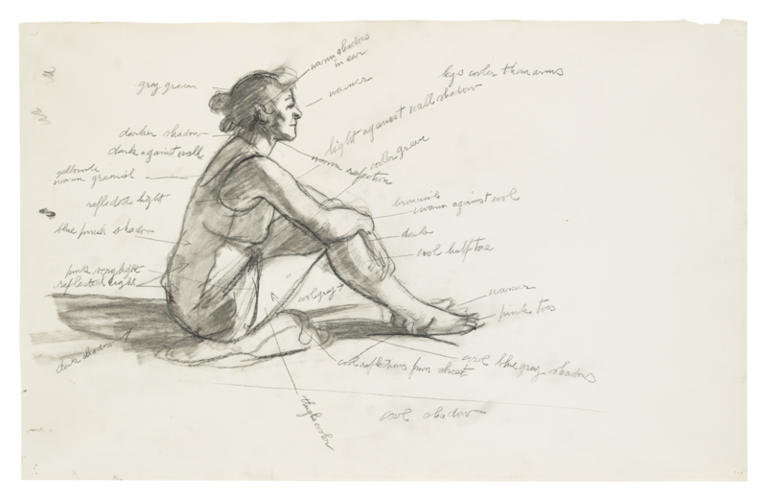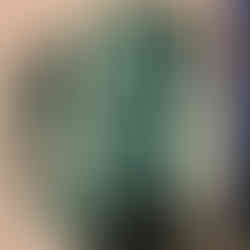I intend this post to be an ongoing repository for research and responses to the chosen artists. I want to come back to them as I progress to if it gives me more ideas or a desire for more responses. So if you find a section incomplete, don't worry - I will be coming back to them!
Butch Belair
In preparation for taking this module, I purchased some books, including the essential texts to help me and give me inspiration. One of the books I bought was "An Illustrated Life" by Danny Gregory. It has loads of different artists and their sketchbooks. One which stood out for me was Butch Belair [1].
I really like the observational content. It makes the seemingly mundane have significance. His line and wash work has a ligne claire feeling to it which I like. In some of his pieces he really emphasises light and shadow, and in in others the colour sits on areas that hold his interest - the rest is incomplete, fades away or is omitted entirely so the image floats in white space. (Which reminds me of the skies in Ian Sidaway's sketchbooks).
I found his work similar to that of Steven B Reddy, whose book "Everyday Sketching & Drawing" [3] I have also purchased and found extremely useful for work on holiday towards Assignment 1. I've really enjoyed focusing on some observational situational sketching, and have fallen back in love with using watercolour more often.
With a number of sketches in my other sketchbook, I didn't have a specific response in my A4 sketchbook. I did, however feel like I needed to get thought down on paper in sketchnote form, which has also helped me with this learning log entry.

Karl Kopinski
I have enjoyed and followed Karl's work since he started work in the Games Workshop illustration team. Karl is obsessed with drawing people. He started when he was at school, capturing the faces of his friends. He dropped out of art college because of his infatuation with portraiture (which abutted to his tutor's needs for him to explore the abstract!).
As such he prolifically sketched in sketchbooks. He does a lot of observational drawing, character doodles, and sometimes mixes both by drawing from life, but transmuting the figure into a fictional setting!
I really enjoy how he uses brush pens. His style is very European and reminds me a lot of the British comics I read as a child. I am fascinated by how places little marks here and there, and suddenly they perfectly capture texture, folds and tones. He also uses pencil, which I am uncomfortable using at the moment. (Saying that, I am not comfortable with ink either, but I still enjoy it). Given his art books you'd think all he does are the characters, but I was pleased to see in the first video below that his sketchbooks have studies, re-works, compositions and preparatory work. He even has bits in there for (and sometimes done by) his kids - just like mine.
In response to Karl's drawings of people, I thought about doing some observational drawing of people from afar and up close. I wanted to just use a brush pen like Karl does and to just draw without any scaffolding. It was OK, but I realised that I was trying to imitate him, rather than doing 'me'. I think the only way I will get better at coming up with great characters, people and poses is to just draw draw draw. I also need to revisit my anatomy book, and look for opportunities for life drawing classes.


Also, I need to think about just going with observational drawing that is mine, rather than perfect. Which reminds me of the life drawings I see from Dan Berry on his Twitter feed - they are still observational but do not try to be quite as accurate as Karl's work. I think the accuracy of Karl comes from his love and obsession with human anatomy. I need to learn what I care about.
Dan's work is much more gestural, and has such life to it. I think perhaps my way is somewhere in between the two.
I realised that I need to know the rules before I could break the rules, so I grabbed "You will be able to draw faces by the end of this book" [8] from my shelf and then used my iPad's camera as a mirror to do a self portrait. I was happy with the pencil drawing but then wanted to experiment with ink, mainly to try and experiment with marks for the hair and stubble. Then I added in a yellow wash background and coloured spectacles for contrast. I really like this page!

Edward Hopper
My obsession with Edward Hopper started when I did GCSE Art & Design. My teacher noted how one of my paintings had elements to Hopper's style. I researched him a lot and fell in love with his work.
The relationship between light and shade features heavily in Hopper's work, and when people do feature there is a sense of isolation and sometimes loneliness. When I was younger I didn't have the internet, so all the resources I found concentrated on his paintings. I was delighted to find so many examples of his sketches online, and I have voraciously accumulated examples.
Hopper did do some sketches and studies in watercolour, but a lot of his sketches seem to be in pencil. What I find interesting is the way that he annotates his sketches, making notes for his use later. He seems to note things like colours and if they are warm, cold, strong, pale etc.
I don't have a direct response to his work at the moment, but I have appreciated looking into his sketches. I feel grateful that his sketchbooks seem quite ordered and focused. I really like the way he uses a storyboarding-like technique when developing his work, so that he can experiment but in a methodical way. This reassures me that taking a considered approach to working out problems is also as acceptable as random experiments.
Syndey Smith
I discovered Sydney Smith whilst researching work for my last module. I love his style and use of ink and watercolour. Unlike the controlled lines of Butch Belair, Sydney's work is much more loose and free. I love his use of colour.
One of the things I noticed and admired was the work from his sketchbook which I found on his blog and Instagram. I like that he does observational drawing, but it's much more subjective, sometimes almost abstract. I am not an art history buff, but his use of ink and colour almost seems impressionistic. Lots of movement, gesture and texture. It's great. I also like how he observes people, and he really uses his loose sheets to experiment with characters ideas and compositions. It's something I learnt from a lot to think about future illustration projects.

My response to this research was to try and do my own observational drawing that was loose and impressionistic. I was stuck indoors due to waiting for a delivery, so I pulled back the curtain and drew the back garden scene in front of me.

It was really fun to force myself to be quick and loose. I pretended I needed to leave the house in 10 minutes, so that gave me impetus to not be precious. I still think I managed to observe well. I got the sense that sometimes less is more, and space can sometimes do as much communication as content.
Turner
I wanted to look into the work of a classic master. I actually don't know much about Turner (apart from the film (Mr Turner, 2014) ). But I know his watercolours are famous. I purchased a book about his sketchbooks [14] and have read quite a lot of it - it's a big book so there is still plenty for me to get through!

I was very surprised to note the economy of his sketches - sometimes they seems so very incomplete. Turner seemed to have a clear


Guillermo Del Toro


Seamus Hefferman
Jonathan Edwards
Bibliography
Gregory, D. (2011). An illustrated life. 7th ed. Cincinnati, Ohio: HOW Books, pp.24-27.
Gregory, D. (2011). To El and Back: a film about Butch Belair. [video] Available at: https://vimeo.com/30244195 [Accessed 9 Sep. 2019].
Reddy, S. (2018). Everyday Sketching and Drawing. 3rd ed. New York: Monacelli Press, Incorporated.
Trojan Horse Was a Unicorn (2018). Sketchbook ep.1 - Karl Kopinski. [video] Available at: https://www.youtube.com/watch?v=I_bBwtn_SnI [Accessed 9 Sep. 2019].
Parka Blogs (2019). The Big Kopinski Volume 1 (book flip). [image] Available at: https://www.youtube.com/watch?v=Z6gtOgPqiyM [Accessed 9 Sep. 2019].
Kopinski, K. (n.d.). Sketches. [online] Art of Karl Kopinski. Available at: https://karlkopinski.com/collections/sketches [Accessed 9 Sep. 2019].
Editions Caurette. (2019). The Big Kopinski - Karl Kopinski - Editions Caurette. [online] Available at: http://caurette.com/en/artbooks/the-big-kopinski/ [Accessed 9 Sep. 2019].
Spicer, J. (2018). You will be able to draw faces by the end of this book. 1st ed. London: Octopus Publishing Group.
Whitney.org. (2019). Hopper Drawing. [online] Available at: https://whitney.org/Exhibitions/HopperDrawing [Accessed 9 Sep. 2019].
Cembalest, R. (2019). How Edward Hopper Storyboarded 'Nighthawks'. [online] ARTnews. Available at: http://www.artnews.com/2013/07/25/how-edward-hopper-storyboarded-nighthawks/ [Accessed 9 Sep. 2019].
Smith, S. (2019). A Road on Toronto Island. [image] Available at: https://66.media.tumblr.com/bf1e577f27236cc67037590c272c2d61/tumblr_om1x3gDrO91r67y1do1_1280.jpg [Accessed 9 Sep. 2019].
Smith, S. (2019). Sydney Draws. [online] Sydneydraws.tumblr.com. Available at: https://sydneydraws.tumblr.com/ [Accessed 9 Sep. 2019].
Smith, S. (2019). Sydney Smith (@sydneydraws) • Instagram photos and videos. [online] Instagram.com. Available at: https://www.instagram.com/sydneydraws/ [Accessed 9 Sep. 2019].
Warrell, I. (2017). Turner's sketchbooks. 1st ed. London: Tate Publishing, pp.30,97,101.
Del Toro, G. (2013). Cabinet of curiosities. 1st ed. London: Titan Books, pp.230, 234.
Gregory, D. (2011). An illustrated life. 7th ed. Cincinnati, Ohio: HOW Books, pp.78-81.
Edwards, J. (n.d.). Sketchbook - Jonathan Edwards Illustration. [online] Jonathan-e.com. Available at: http://www.jonathan-e.com/sketchbook/4519134843 [Accessed 9 Sep. 2019].





















































Comments